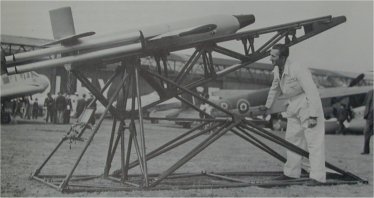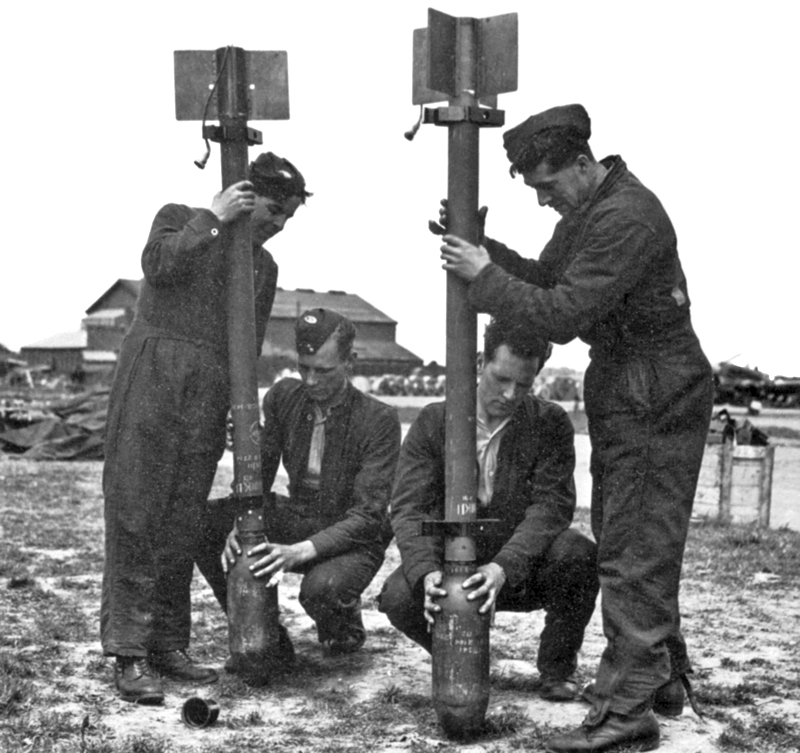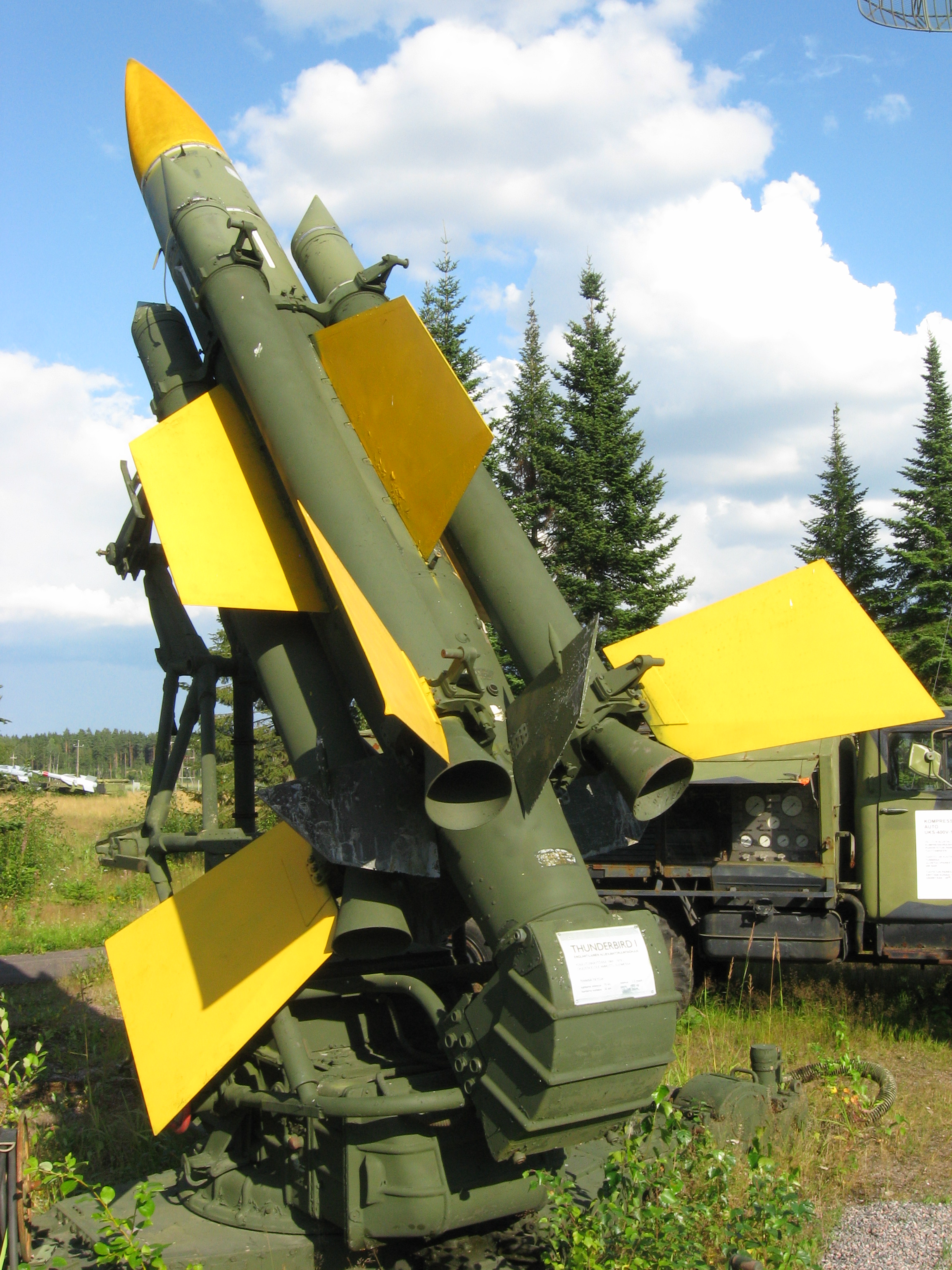|
Brakemine
Brakemine was an early surface-to-air missile (SAM) development project carried out in the United Kingdom during World War II. Brakemine used a beam riding guidance system developed at A.C. Cossor, while REME designed the testbed airframes. Trial launches were carried out between 1944 and 1945, and the effort wound down as the war ended. Although Brakemine would never be used in its original form, its use of the "twist-and-steer" guidance method would later be used on the more capable LOPGAP design, which, after major changes, emerged as the Bristol Bloodhound. A single Brakemine survives in the REME Museum. History Brakemine was the result of two independently developed versions of the beam riding guidance system concept. In 1942, Captain Sedgfield of the Royal Electrical and Mechanical Engineers (REME) wrote a technical paper on the concept. In 1943, Leslie Herbert Bedford, director of research at A.C. Cossor, independently developed the same idea while on a long train ride. ... [...More Info...] [...Related Items...] OR: [Wikipedia] [Google] [Baidu] |
LOPGAP
Seaslug was a first-generation surface-to-air missile designed by Armstrong Whitworth (later part of the Hawker Siddeley group) for use by the Royal Navy. Tracing its history as far back as 1943's LOPGAP design, it came into operational service in 1961 and was still in use at the time of the Falklands War in 1982. Seaslug was intended to engage high-flying targets such as reconnaissance aircraft or bombers before they could launch stand-off weapons. It was only fitted to the Royal Navy's eight County-class destroyers which were designed around the missile system. Seaslug was only fired in anger once as an anti-aircraft missile, from during the Falklands War, but missed its target. Later improvements meant that it could also be used against ships and ground targets. It was planned that Seaslug's medium-range role was to be supplanted by a very long-range missile known as Blue Envoy, but this was passed over in favour of a new medium-range system, Sea Dart. Sea Dart entered servic ... [...More Info...] [...Related Items...] OR: [Wikipedia] [Google] [Baidu] |
Bristol Bloodhound
The Bristol Bloodhound is a British ramjet powered surface-to-air missile developed during the 1950s. It served as the UK's main air defence weapon into the 1990s and was in large-scale service with the Royal Air Force (RAF) and the forces of four other countries. Part of sweeping changes to the UK's defence posture, the Bloodhound was intended to protect the RAF's V bomber bases to preserve the deterrent force, attacking bombers that made it past the Lightning interceptor force. Bloodhound Mk. I entered service in December 1958, the first British guided weapon to enter full operational service. This was part of Stage 1 upgrades to the defensive systems, in the later Stage 2, both Bloodhound and the fighters would be replaced by a longer-range missile code named Blue Envoy. When this was ultimately cancelled in 1957, parts of its design were worked into Bloodhound Mk. II, roughly doubling the range of the missile. The Mk. I began to be replaced by the Mk. II starting in 1964 ... [...More Info...] [...Related Items...] OR: [Wikipedia] [Google] [Baidu] |
Surface-to-air Missile
A surface-to-air missile (SAM), also known as a ground-to-air missile (GTAM) or surface-to-air guided weapon (SAGW), is a missile designed to be launched from the ground to destroy aircraft or other missiles. It is one type of anti-aircraft system; in modern armed forces, missiles have replaced most other forms of dedicated anti-aircraft weapons, with anti-aircraft guns pushed into specialized roles. The first attempt at SAM development took place during World War II, but no operational systems were introduced. Further development in the 1940s and 1950s led to operational systems being introduced by most major forces during the second half of the 1950s. Smaller systems, suitable for close-range work, evolved through the 1960s and 1970s, to modern systems that are man-portable. Shipborne systems followed the evolution of land-based models, starting with long-range weapons and steadily evolving toward smaller designs to provide a layered defence. This evolution of design increasin ... [...More Info...] [...Related Items...] OR: [Wikipedia] [Google] [Baidu] |
Fairey Stooge
The Fairey Aviation Stooge was a command guided surface-to-air missile (SAM) development project carried out in the United Kingdom starting in World War II. Development dates to a British Army request from 1944, but the work was taken over by the Royal Navy as a potential counter to the Kamikaze threat. Development was not complete when the war ended, but the Ministry of Supply funded further development and numerous test launches into 1947, assisting in the development of more advanced successor missiles. Development During World War II a number of efforts were started to develop surface-to-air missiles as it was generally considered that flak was of little use against bombers of ever-increasing performance. While the Germans developed a number of systems in an attempt to deter Allied bombing, the overwhelming air superiority held by the Allies meant that the prospect of developing similar weapons was largely ignored as unnecessary. This changed when the Kamikaze threat spread in ... [...More Info...] [...Related Items...] OR: [Wikipedia] [Google] [Baidu] |
Beam Riding
Beam-riding, also known as Line-Of-Sight Beam Riding (LOSBR) or beam guidance, is a technique of directing a missile to its target by means of radar or a laser beam. The name refers to the way the missile flies down the guidance beam, which is aimed at the target. It is one of the simplest guidance systems and was widely used on early missile systems, however it had a number of disadvantages and is now found typically only in short-range roles. Basic concept Beam riding is based on a signal that is pointed towards the target. The signal does not have to be powerful, as it is not necessary to use it for tracking as well. The main use of this kind of system is to destroy airplanes or tanks. First, an aiming station (possibly mounted on a vehicle) in the launching area directs a narrow radar or laser beam at the enemy aircraft or tank. Then, the missile is launched and at some point after launch is “gathered” by the radar or laser beam when it flies into it. From this stage onwa ... [...More Info...] [...Related Items...] OR: [Wikipedia] [Google] [Baidu] |
RP-3
The RP-3 (from Rocket Projectile 3 inch) was a British air to ground rocket projectile introduced during the Second World War. The "3 inch" designation referred to the nominal diameter of the rocket motor tube. The use of a warhead gave rise to the alternative name of the "60-pound rocket". Though primarily an air-to-ground weapon, it saw limited use in other roles. They were generally used by British fighter-bomber aircraft against targets such as tanks, trains, motor transport and buildings, as well as by Coastal Command and Royal Navy aircraft against U-boats and ships. Use continued post-war, with the last known major operational use being during the Aden Emergency in 1964, where Hawker Hunters flew 642 sorties and fired 2,508 RP-3s in support of Radforce. Use continued until the withdrawal from Aden in November 1967, at which point the RP-3 was withdrawn from service in favour of the newer SNEB. Concerned about the possibility of shipboard radar setting off the SNEB's elec ... [...More Info...] [...Related Items...] OR: [Wikipedia] [Google] [Baidu] |
REME Museum Of Technology
The REME Museum is within the MoD Lyneham site, in Wiltshire, England, about southwest of Swindon. The museum holds collections of technological and historical artifacts associated with the work of the Royal Electrical and Mechanical Engineers ('REME'), the corps of the British Army responsible for the maintenance, servicing and inspection of electrical and mechanical equipment. History The REME Museum started in 1958 in Arborfield, Berkshire. It was originally located in two rooms of Moat House, the former commander's accommodation of the Arborfield Army Remount Service Depot. Over time the museum moved to a neighboring building and expanded to allow more objects and vehicles to be displayed. In April 2015, the museum closed in preparation for its relocation from Berkshire to MoD Lyneham as part of the Defence Technical Training Change Programme. The former Officers' Mess at Lyneham was modified to provide a new home for the museum. This allowed a complete refresh of the displ ... [...More Info...] [...Related Items...] OR: [Wikipedia] [Google] [Baidu] |
English Electric Thunderbird
The English Electric Thunderbird was a British surface-to-air missile produced for the British Army. Thunderbird was primarily intended to attack higher altitude targets at ranges up to approximately , providing wide-area air defence for the Army in the field. AA guns were still used for lower altitude threats. Thunderbird entered service in 1959 and underwent a major mid-life upgrade to Thunderbird 2 in 1966, before being slowly phased out by 1977. Ex-Army Thunderbirds were also operated by the Royal Saudi Air Force after 1967. Thunderbird had performance similar to other semi-portable missiles like the US MIM-23 Hawk and fully mobile Soviet 2K11 Krug, although it pre-dates both of these systems. After its mid-life upgrades, which shared several components with the RAF's Bristol Bloodhound, Thunderbird featured a continuous-wave radar semi-active homing system that was highly resistant to radar jamming and deception, and was able to track targets even at very low altitudes. T ... [...More Info...] [...Related Items...] OR: [Wikipedia] [Google] [Baidu] |
RAF Aberporth
Aberporth is a seaside village, community and electoral ward in Ceredigion, Wales. The population at the 2001 Census, was 2,485, of whom 49 per cent could speak the Welsh language. At the 2011 Census, the population of the community was 2,374 and of the village 1241. Aberporth's beaches have earned Blue Flag status. Location Aberporth is on the Ceredigion Coast Path, part of the Wales Coast Path, at the southern end of Cardigan Bay, about northeast of Cardigan and southwest of New Quay. The Fishguard to Bangor Trunk Road ( A487) is reached via the B4333 road in about . Etymology The name Aberporth is first recorded in 1284, and is derived from the Old Welsh “aber” (mouth) and “porth” (port). History In the 16th century, boats, nets and salt for preserving were brought in from Ireland. Aberporth became a subsidiary port of Cardigan. The landing point developed rapidly in the late 17th and early 18th centuries as local people began to take part in the mariti ... [...More Info...] [...Related Items...] OR: [Wikipedia] [Google] [Baidu] |
Ministry Of Supply
The Ministry of Supply (MoS) was a department of the UK government formed in 1939 to co-ordinate the supply of equipment to all three British armed forces, headed by the Minister of Supply. A separate ministry, however, was responsible for aircraft production, and the Admiralty retained responsibilities for supplying the Royal Navy.Hornby (1958) During the war years the MoS was based at Shell Mex House in The Strand, London. The Ministry of Supply also took over all army research establishments in 1939. The Ministry of Aircraft Production was abolished in 1946, and the MoS took over its responsibilities for aircraft, including the associated research establishments. In the same year, it also took on increased responsibilities for atomic weapons, including the H-bomb development programme. The Ministry of Supply was abolished in late 1959 and its responsibilities passed to the Ministry of Aviation, the War Office, and the Air Ministry. The latter two ministries were subs ... [...More Info...] [...Related Items...] OR: [Wikipedia] [Google] [Baidu] |
Proximity Fuse
A proximity fuze (or fuse) is a fuze that detonates an explosive device automatically when the distance to the target becomes smaller than a predetermined value. Proximity fuzes are designed for targets such as planes, missiles, ships at sea, and ground forces. They provide a more sophisticated trigger mechanism than the common contact fuze or timed fuze. It is estimated that it increases the lethality by 5 to 10 times, compared to these other fuzes. Background Before the invention of the proximity fuze, detonation was induced by direct contact, a timer set at launch or an altimeter. All of these earlier methods have disadvantages. The probability of a direct hit on a small moving target is low; a shell that just misses the target will not explode. A time- or height-triggered fuze requires good prediction by the gunner and accurate timing by the fuze. If either is wrong, then even accurately aimed shells may explode harmlessly before reaching the target or after passing it. At th ... [...More Info...] [...Related Items...] OR: [Wikipedia] [Google] [Baidu] |







.jpg)